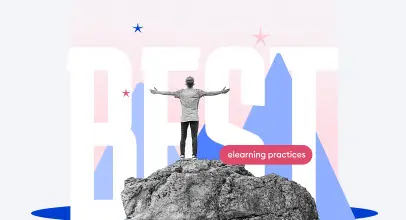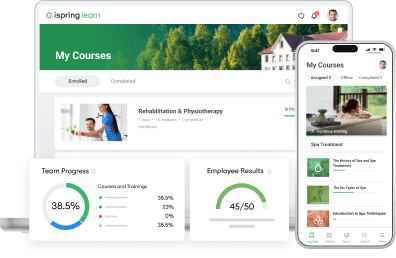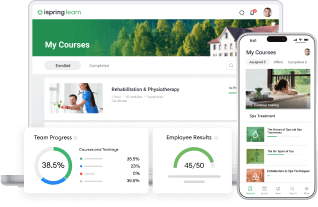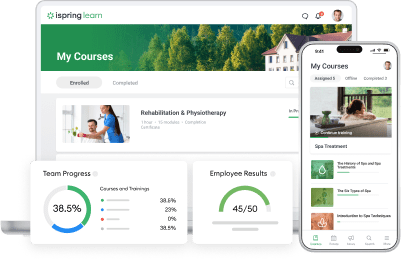eLearning for Sales Training: Train Faster, Sell More

Nowadays, consumers have endless choices, unlimited information, and an inherent skepticism about sales pitches. If you don’t have the right sales strategy, they’ll give you a polite nod and disappear faster than a free trial that requires a credit card. Your salespeople must be impeccably educated and armed with all the necessary knowledge and information to win customers’ attention and love for your products.
In this article, we’ll explain how eLearning can help you train your sales team so they’re fully prepared to close lucrative deals. You’ll find out about the benefits, best use cases, and examples of online sales training, as well as some practical tips to make sure you get it right.
Benefits of Online Sales Training
If your sales aren’t as efficient as you expect them to be, you’re not alone. Statistics say that approximately 55% of salespeople fail to meet their sales objectives. Common challenges faced by businesses in sales include:
- Inconsistent sales methodology
- Lack of product knowledge
- Poor lead qualification
- Weak closing skills
- Ineffective communication skills
There would be one natural solution for all of these issues: educating your sales team. Continuous training gives 50% higher net sales per employee. Modern salespeople have to possess an impressive array of skills, but where do they find the time and energy to study? That’s where online training comes into play.
Research indicates that of companies that offer online learning, more than two in five see an increase in income. Moreover, online learning improves employee performance by at least 15%. If your business is looking to improve its sales processes, we recommend that you look into integrating online sales training, and here’s why:
Cost efficiency
Offline training naturally incurs higher costs, such as travel, accommodation, and lecturers’ fees. eLearning eliminates all of those expenses and delivers consistent, high-quality training for employees. Additionally, online training has other built-in perks, like automated analytics, streamlined assessment, or microlearning. So, when you choose eLearning, you get many more possibilities while you pay less.
Flexibility and convenience
Sales managers are always busy and don’t like to be distracted from their direct responsibilities of negotiating with customers and closing deals. Online training allows them to study at their own pace. This is particularly relevant for global teams located in different time zones.
Scalability
As your business grows and expands into new markets, your sales team needs to grow along with it. eLearning allows you to scale training initiatives to accommodate large sales teams across various locations without compromising quality.
Consistency
If you hire two different sales trainers from two teams, you can get two teams with completely different knowledge and understanding of the sales techniques and processes. Online training methods ensure that all sales reps receive the same message and training materials, helping to standardize the learning experience.
Trackable progress
The ultimate game changer offered by eLearning to businesses is reporting and analytics. L&D departments can now measure KPIs more precisely and make the necessary adjustments to various business processes, identifying areas of improvement for teams, departments, and individual sales reps.
The 5 Best Use Cases for eLearning in Sales Training
eLearning isn’t just about convenience — it’s about boosting efficiency, sharpening skills, and driving real sales results. Below, you’ll discover the five most impactful ways to use eLearning for sales training.
Use Case #1: Onboarding
Sales departments can be faced with a high turnover of employees; that’s why streamlined onboarding procedures for new sales reps guarantee a smoother sales process. eLearning courses help organize onboarding by providing a self-paced and engaging learning experience. New employees can:
- Learn about company culture, policies, and procedures.
- Review product offerings and services.
- Familiarize themselves with the sales process and tools.
- Receive consistent, standardized training, ensuring they don’t miss out on crucial information.
For example, at iSpring, we were able to build an onboarding process that we’re truly proud of. Having identified some issues in our past onboarding strategies, with precise planning and goal setting, we combined product and sales training in a straightforward learning path using the iSpring Learn sales training LMS.
As a result, the time required for sales reps to reach full productivity was reduced from 7 to 3 weeks, and onboarding was standardized with clear performance expectations.
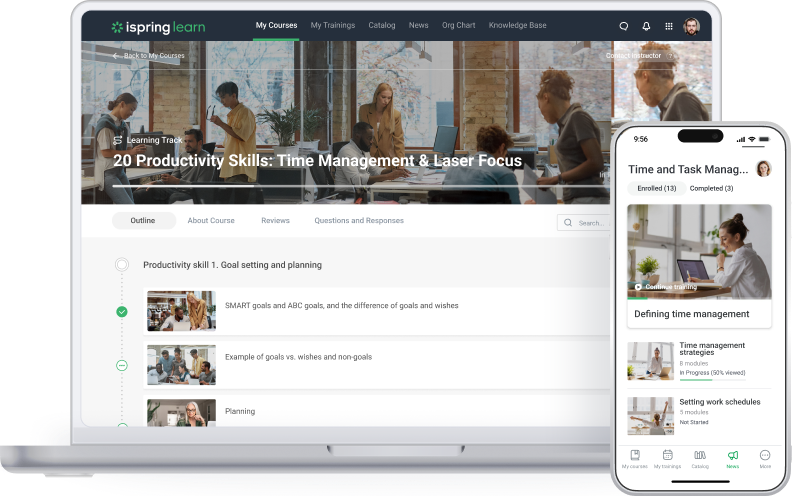
As one of the steps, we divided the content into weeks and days to make the structure clear and simple for newcomers to follow. Now, they always know what to do and don’t distract top sales performers from their primary tasks.
All of the courses within the learning path are available at once, so the learner can perform the next one while the previous assignment is waiting to be checked. At the end, the learner’s progress is viewed in perfect detail, thanks to numerous reports.
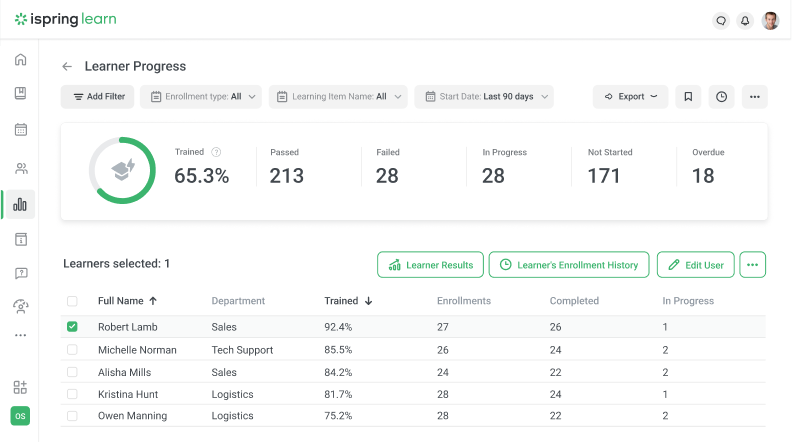
We use the iSpring Suite authoring tool to create video lectures, interactive role-plays, and multiple quizzes effectively. Adding audio, video, and interactivity to our onboarding courses makes them more captivating and helps newbies retain new information better.
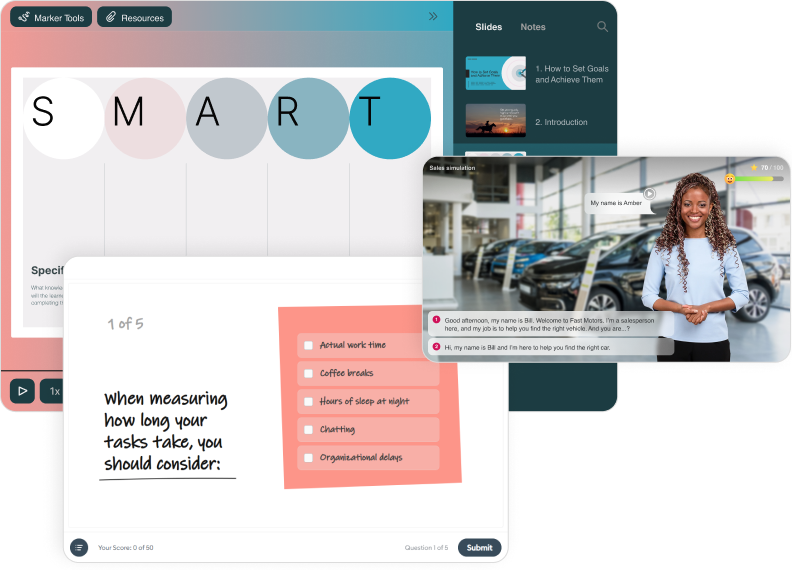
Use Case #2: Product Training
Sales reps must possess a deep knowledge of the products or services they sell to be effective. eLearning makes it easier to deliver product training courses through various formats, such as:
- Interactive modules showcasing key product features.
- Video demonstrations of product use and application.
- Quizzes and assessments to test product knowledge.
One advantage of online training is that product knowledge can be continually refreshed, thereby ensuring that sales reps remain updated on new features or updates.
For example, at Santé Verte Laboratories, the Training Department uses iSpring solutions to test the knowledge of 100+ salespeople who work closely with pharmacies selling a wide range of herbal complex supplements. The assessment process takes place with the help of interactive quizzes that can be built easily with iSpring Suite.
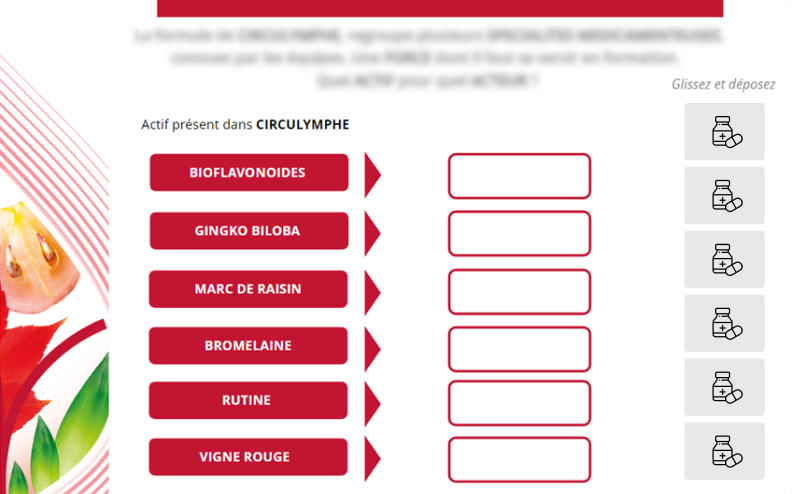
Use Case #3: Standards and Best Practices
Sales teams must adhere to specific standards and best practices to maintain consistency and drive sales success. eLearning enables sales representatives to:
- Learn proven sales techniques.
- Familiarize themselves with compliance and regulatory guidelines.
- Master company standards and practices to improve efficiency and increase sales.
Through eLearning, sales managers can constantly revisit and refresh these standards to enhance their sales skills.
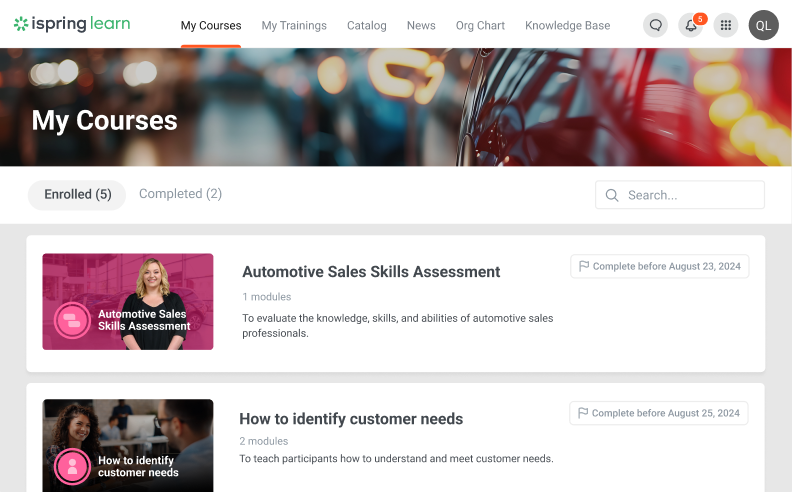
Use Case #4: Industry Specifics
Every industry has its nuances and specific demands. Sales teams that operate in niche markets or specialized sectors need to have in-depth knowledge of those specificities. An industry-specific training program helps by:
- Delivering specialized content that’s relevant to the industry.
- Providing in-depth case studies and examples from within the industry.
- Updating reps on trends, innovations, and shifts in industry dynamics.
This targeted approach helps equip sales teams with the expertise needed to approach clients in their industry effectively.
For example, Suzuki Australia is using iSpring Learn and iSpring Suite to run corporate training for the entire technical and sales staff at their 115 motorcycle and 96 automobile dealerships across the country. They upload both technical and sales training programs to the iSpring Learn LMS and run weekly reports to determine which dealers have completed the training.
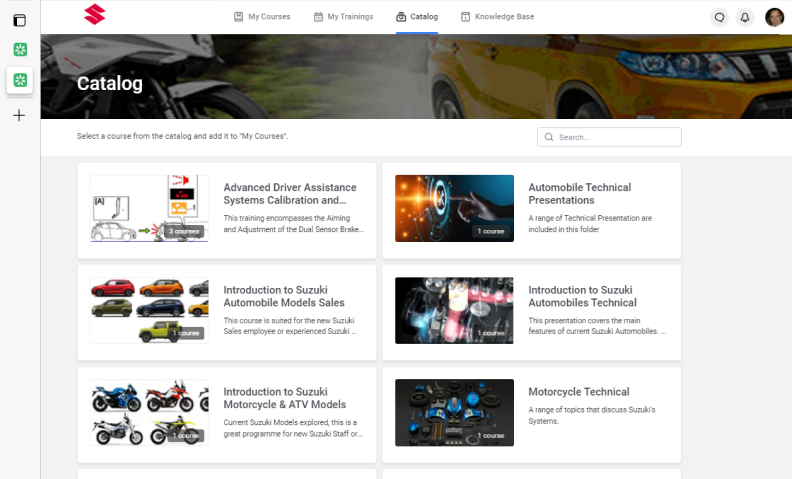
Use Case #5: Performance Review
Performance reviews are an essential part of sales training. eLearning platforms can integrate performance review processes to:
- Offer personalized feedback based on assessment scores or sales data.
- Provide ongoing training suggestions for underperforming reps.
- Reinforce positive behaviors and successful strategies that drive sales.
For example, iSpring Learn has a 360° Review module that can help you evaluate employees using 360-degree feedback. It allows you to create questionnaires, evaluate employees, and, based on the feedback, create your employee development plan. This feature is mostly focused on boosting employees’ soft skills and helps you identify high-potential employees who can advance your business to a new level.
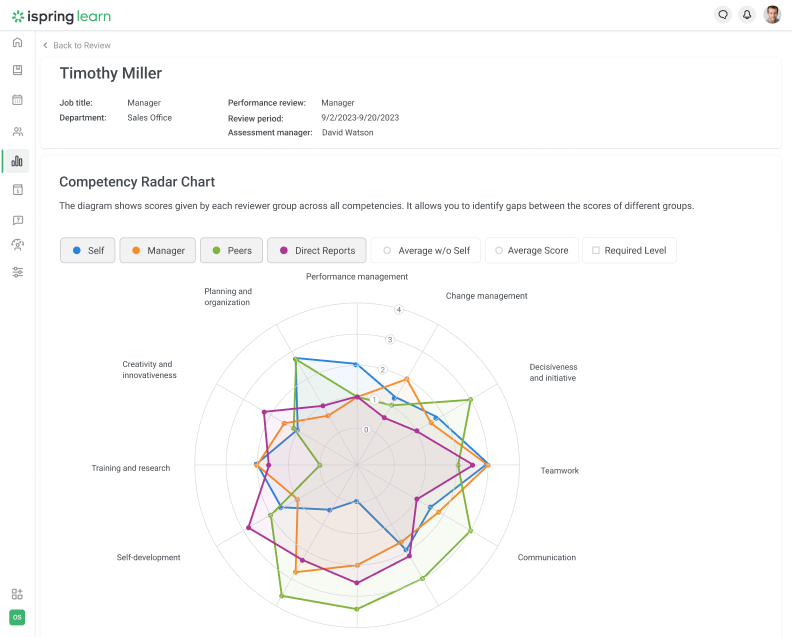
The Limits of eLearning for Training Sales Reps
While eLearning offers numerous advantages, it sometimes may not be a one-size-fits-all solution. There are limitations to consider when using it for sales training:
- Lack of real-time interaction. Online training cannot replicate real-time, personal interaction. Some complex topics require in-depth discussion that can only happen in face-to-face training.
- Engagement issues. Some learners might struggle to stay motivated when they complete training in an online environment, especially without social interaction or immediate feedback from an instructor during training sessions.
- Technical challenges. Not all employees are equally tech-savvy, and some may face difficulties navigating the eLearning platforms. This can slow down the training process.
Some people think eLearning can only be effective for hard knowledge and may not always provide the tools for developing soft skills like empathy, communication, and negotiation. And that’s actually a common misconception. In reality, 60% of online students report improved soft skills such as teamwork, communication, and time management. Indeed, modern online learning tools like VR, simulations, and interactive learning scenarios can eliminate many of the borders between online and offline training.
Moreover, when combined with in-person or live training opportunities, eLearning can offer an effective, flexible, and scalable solution for sales professionals.
eLearning Sales Training Tips
To maximize the effectiveness of eLearning in sales training, consider the following tips:
Start with a needs assessment
Don’t just jump into creating content. First, it’s important to identify specific skill gaps and areas for improvement within the sales team.
Best Practices:
- Conduct surveys or interviews to assess current skills.
- Analyze sales performance data to identify common challenges.
- Involve managers and team leads in defining training needs.
Read more: How to Conduct a Training Needs Assessment (+ Template)
Define clear objectives and learning outcomes
Without clear objectives, sales training can become unfocused and ineffective. Clearly defined learning outcomes ensure that sales reps understand the skills they need to acquire and how they will be assessed. For example: “After completing this module, salespeople will be able to successfully qualify leads using the BANT criteria with 80% accuracy.”
Best Practices:
- Use the SMART goal framework (Specific, Measurable, Achievable, Relevant, Time-bound) for learning objectives.
- Align training goals with real business outcomes, e.g., increasing conversion rates by 10%.
- Communicate objectives before the training begins in order to establish expectations.
Choose the right learning management system
This is crucial. Choosing the right eLearning management platform ensures seamless content delivery, tracking, and scalability. Don’t assume the cheapest option is the best.
Best Practices:
- Look for mobile-friendly platforms for on-the-go learning.
- Choose an LMS with gamification features to keep sales reps engaged.
- Ensure integration with CRM tools to connect training with sales performance stats.
There are many powerful LMS options for sales training. For example, TalentLMS is known for its user-friendly interface and the ability to create adaptive courses quickly, while LearnUpon offers advanced analytics and CRM integrations, making it ideal for large organizations. iSpring Learn is a cost-effective eLearning solution that will allow you to launch and automate online sales training. It will help you organize all your training materials and courses and will allow you to update and access them with ease anytime.
Book a live demo to see how iSpring Learn supports your sales training goals.
Create engaging content
Sales reps are naturally social and action-oriented. Static, text-heavy training modules can bore them, leading to disengagement. To keep them involved, include videos, simulations, and quizzes in your sales training.
Best Practices:
- Use brief video lessons (3–5 minutes per topic) instead of lengthy lectures.
- Add quizzes and knowledge checks to reinforce learning.
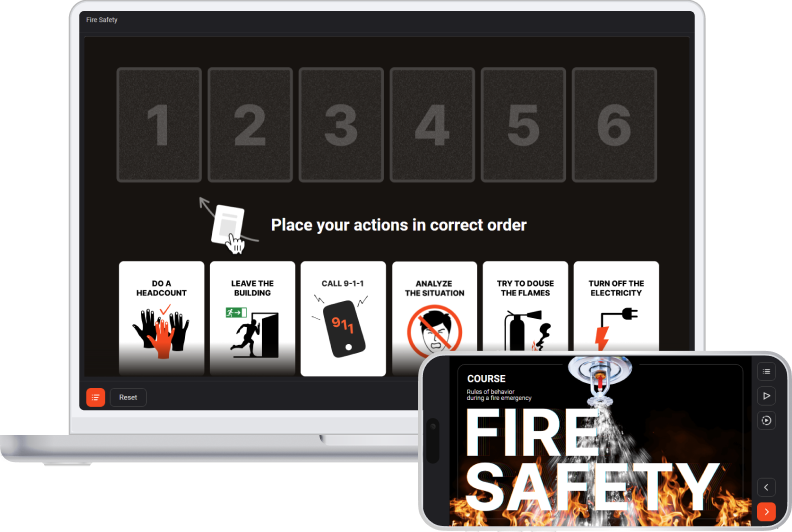
Gamify training
Gamification taps into our natural competitiveness, making learning more enjoyable and rewarding. Leaderboards, points, badges, and competitions can keep sales reps motivated to complete their training.
Best Practices:
- Award badges or certificates for completing modules.
- Use a leaderboard system to track progress and recognize top performers.
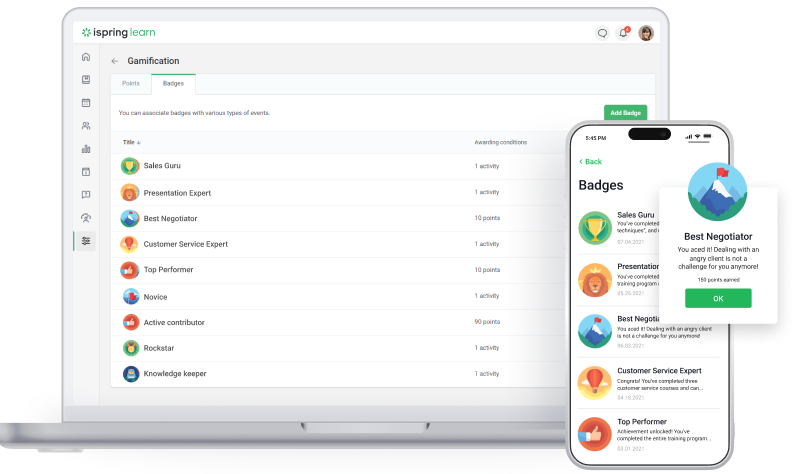
Offer continuous learning and microlearning
Sales is a fast-evolving field, and training shouldn’t be a one-time event. Continuous learning keeps reps updated on new sales techniques, industry trends, and product developments. Microlearning — small, bite-sized lessons — makes it easy for reps to learn on the go.
Best Practices:
- Provide bite-sized product training courses to stay on top of sales skills.
- Offer on-demand learning resources accessible from mobile devices.
- Update content regularly to reflect market trends and new strategies.
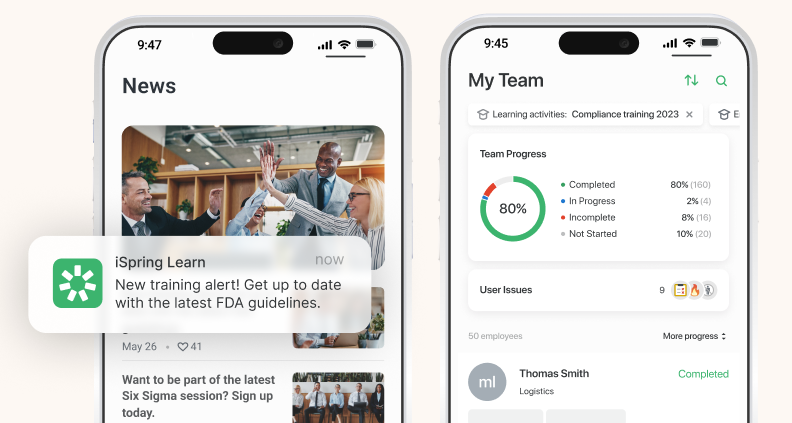
Use analytics for improvement
Leverage analytics tools within the eLearning platform to track learner progress, identify knowledge gaps, and improve future training materials.
For example, the iSpring Learn platform allows for real-time tracking, ensuring that L&D departments can:
- Monitor training completion rates.
- Identify knowledge gaps.
- Generate compliance audit reports easily.
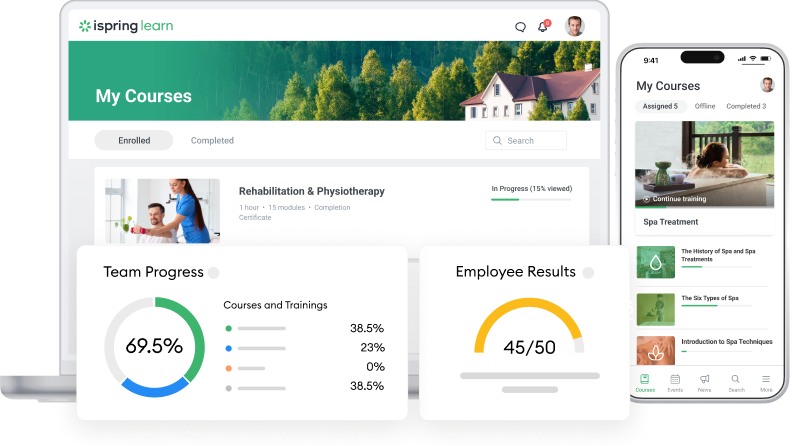
Incorporate real-life scenarios
Sales reps learn best through practice. Incorporate real-world sales scenarios and role-playing exercises to help salespeople put training into practice.
Best Practices:
- Use virtual role-playing exercises in a risk-free environment.
- Provide actual customer case studies for analysis.
- Include recorded sales call breakdowns to illustrate best practices.
For example, the iSpring Suite Max authoring tool allows you to create complex dialog simulations with a wide range of characters and locations for a more realistic feel.

How to Measure the Success of eLearning Implementation
Implementing eLearning for sales training is a strategic investment, but how do you know if it’s truly making an impact? To ensure that your training program is effective, you need to track key performance indicators that measure both learning engagement and actual business outcomes.
Sales performance improvement
Revenue growth. Compare sales performance before and after implementing training.
Conversion rates. Measure how many leads turn into paying customers after reps complete training.
Average deal size. Check to see if trained salespeople are closing bigger deals.
Reduction in onboarding time
Time to first sale. Measure how quickly new reps make their first successful deal.
Completion rate of onboarding modules. Track how many new hires complete their training within the expected timeframe.
Manager feedback. Collect qualitative insights on whether new employees are ready to sell sooner.
Employee engagement and course completion rates
Course completion rates. A high percentage indicates that reps find the content useful and accessible.
Quiz scores and assessments. Low scores indicate areas where the training needs improvement.
ROI of eLearning implementation
Training cost vs. revenue growth. Compare the investment in eLearning with increased sales performance.
Increase in productivity. Calculate the time saved compared to traditional training methods.
Reduction in training costs. Measure savings from eliminating travel, instructor fees, and venue costs.
Conclusion
Due to technological advancements over the past 5-6 years, the eLearning industry for online sales training has evolved from:
- Static content to immersive, interactive experiences.
- One-size-fits-all approaches to personalized, data-driven learning.
- Desktop-only solutions to mobile, on-demand platforms.
- Isolated learning sessions to integrated, collaborative ecosystems.
Whether you’re onboarding new hires, improving product knowledge, or standardizing best practices, eLearning can be adapted to suit a wide range of use cases. While there are limitations, these can be addressed with a strategic blend of digital and in-person training, ensuring that your sales team is always equipped with the knowledge and skills they need to succeed.
By following the tips outlined above, you can harness the full potential of eLearning for your sales training programs and drive greater performance within your sales teams.
